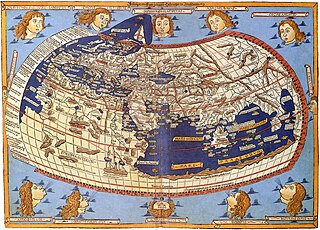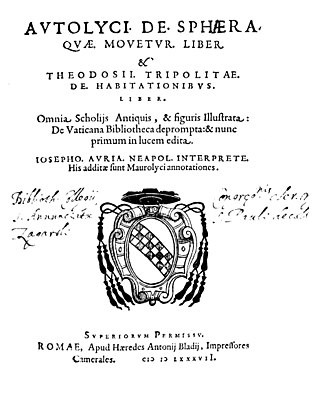In the mathematical field of geometric topology, the Poincaré conjecture is a theorem about the characterization of the 3-sphere, which is the hypersphere that bounds the unit ball in four-dimensional space.

A sphere is a geometrical object that is a three-dimensional analogue to a two-dimensional circle. Formally, a sphere is the set of points that are all at the same distance r from a given point in three-dimensional space. That given point is the center of the sphere, and r is the sphere's radius. The earliest known mentions of spheres appear in the work of the ancient Greek mathematicians.

In astronomy and navigation, the celestial sphere is an abstract sphere that has an arbitrarily large radius and is concentric to Earth. All objects in the sky can be conceived as being projected upon the inner surface of the celestial sphere, which may be centered on Earth or the observer. If centered on the observer, half of the sphere would resemble a hemispherical screen over the observing location.

In cartography, a map projection is any of a broad set of transformations employed to represent the curved two-dimensional surface of a globe on a plane. In a map projection, coordinates, often expressed as latitude and longitude, of locations from the surface of the globe are transformed to coordinates on a plane. Projection is a necessary step in creating a two-dimensional map and is one of the essential elements of cartography.

Spherical geometry or spherics is the geometry of the two-dimensional surface of a sphere or the n-dimensional surface of higher dimensional spheres.

Spherical trigonometry is the branch of spherical geometry that deals with the metrical relationships between the sides and angles of spherical triangles, traditionally expressed using trigonometric functions. On the sphere, geodesics are great circles. Spherical trigonometry is of great importance for calculations in astronomy, geodesy, and navigation.

Autolycus of Pitane was a Greek astronomer, mathematician, and geographer. He is known today for his two surviving works On the Moving Sphere and On Risings and Settings, both about spherical geometry.
Oscar Howe was a Yanktonai Dakota artist from South Dakota, who became well known for his casein and tempera paintings. He is credited with influencing contemporary Native American art, paving the way for future artists. His art style is marked by bright color, dynamic motion and pristine lines.

Father Magnus J. Wenninger OSB was an American mathematician who worked on constructing polyhedron models, and wrote the first book on their construction.
Ivars Peterson is a Canadian mathematics writer.

MathPath is a mathematics enrichment summer program for students ages 11–14. It is four weeks long, and moves to a different location each year. MathPath is visited by mathematicians such as John H. Conway and Francis Su. It was probably the original, and is still one of the few, international residential high-end summer camps exclusively for mathematics and exclusively for students of middle school age.

Mathematical beauty is the aesthetic pleasure derived from the abstractness, purity, simplicity, depth or orderliness of mathematics. Mathematicians may express this pleasure by describing mathematics as beautiful or describe mathematics as an art form, or, at a minimum, as a creative activity.
The culture of the U.S. state of South Dakota exhibits influences from many different sources. American Indians, the cultures of the American West and Midwest, and the customs and traditions of many of the state's various immigrant groups have all contributed to South Dakota art, music, and literature.

Mathematics and art are related in a variety of ways. Mathematics has itself been described as an art motivated by beauty. Mathematics can be discerned in arts such as music, dance, painting, architecture, sculpture, and textiles. This article focuses, however, on mathematics in the visual arts.

Arthur Douglas Amiotte is an Oglala Lakota Native American painter, collage artist, educator, and author.

The Pacific Institute for the Mathematical Sciences (PIMS) is a mathematical institute created in 1996 by universities in Western Canada and the Northwestern United States to promote research and excellence in all areas of the mathematical sciences. It provides training and support for graduate students and post-doctoral researchers hosted at member institutions. It also supports visiting researchers and hosts events ranging from individual lectures to multi-year "collaborative research groups (CRGs)" in the mathematical sciences. Additionally, PIMS has a large educational outreach program aimed at promoting mathematics at all levels but with particular focus on primary and secondary levels (K–12).

In the mathematical theory of minimal surfaces, the double bubble theorem states that the shape that encloses and separates two given volumes and has the minimum possible surface area is a standard double bubble: three spherical surfaces meeting at angles of 120° on a common circle. The double bubble theorem was formulated and thought to be true in the 19th century, and became a "serious focus of research" by 1989, but was not proven until 2002.
Gathering 4 Gardner (G4G) is an educational foundation and non-profit corporation devoted to preserving the legacy and spirit of prolific writer Martin Gardner. G4G organizes conferences where people who have been inspired by or have a strong personal connection to Martin Gardner can meet and celebrate his influence. These events explore ideas and developments in recreational mathematics, magic, illusion, puzzles, philosophy, and rationality, and foster creative work in all of these areas by enthusiasts of all ages. G4G also facilitates a related series of events called Celebration of Mind (CoM).

Maryna Sergiivna Viazovska is a Ukrainian mathematician known for her work in sphere packing. She is a full professor and Chair of Number Theory at the Institute of Mathematics of the École Polytechnique Fédérale de Lausanne in Switzerland. She was awarded the Fields Medal in 2022.















